Table of Contents
ToggleIntroduction
Up for review is the EP-8K7A, EpoX's AMD760 based motherboard. Like all boards I know, which feature AMDs DDR chipset, it uses AMD's 761 northbridge and the VIA 686B southbridge. Typical for EpoX, the board is packed with OC features. But in contrary to the older 8KTA3 model, for example, most of them require the usage of DIP switches or jumpers. We'll get to that in more detail later.
In the 3dfx scene, this is a very highly regarded motherboard for its compatibility and performance with 3dfx Voodoo 5 cards (5500 as well as 6000). We'll see how it fares in that regard later.
The EP-8K7A is available in two different versions, with the EP-8K7A (like this one) being the base model. The second one is the EP-8K7A+, which comes with a Highpoint HPT370 chip, that provides RAID functionality on the two additional UDMA100 IDE ports.
It is also important to note, that only the Rev. 1.1 boards support Athlon XP and Duron Morgan CPUs, the 1.0 boards are limited to the classic Thunderbird and Spitfire Core CPUs.
Gallery
Specifications and Features
Chipset:
- AMD 761 Northbridge
- VIA 686B Southbridge
CPU Support (with latest BIOS):
- Athlon Thunderbird (ALL)
- Athlon XP Palomino (ALL, if board revision is 1.1)
- Athlon XP Thoroughbred 2200 (if board revision is 1.1)
- Duron Spitfire (ALL)
- Duron Morgan (ALL, if board revision is 1.1)
Memory Support:
- 2 DDR DIMM slots, up to 2 GB total* (the manual states max. 1 GB (2x 512 MB))
Expansion Slots:
- 1x AGP slot (1,5 / 3,3V) up to 4x
- 6x PCI slots
Connectors (internal):
- 2x IDE (UDMA100)
- 1x Floppy
- 1x USB 1.1
- 3x 3-pin fan connectors total (1x CPU, 2x chassis)
Connectors (external):
- 2x PS/2
- 2x COM/RS-232
- 1x Parallel Port
- 2x USB 1.1
- 3x 3,5" Audio Jacks (Line-Out, Line-In, Mic)
- Gameport
You might have noticed, that I didn't mention the audio chipset specifically, as I think far better solutions than the old onboard chipsets are readily available for little money. Very commonly recommended are the Creative Soundblaster Live! cards for example, which offer fantastic compatibility with our beloved old games and sound far better than any onboard solution of that era.
I also don't list (from a retro-gamers perspective) useless connectors and features like IR, Smartcard- or Wake-on-LAN connectors and so on.
Overclocking Features:
- Adjustable Multiplier (DIP) from x5 - x12,5
- Adjustable FSB (BIOS) 100 - 166 MHz and 133 - 250 MHz in steps of 1 MHz
- Adjustable VCore (jumper) +0,100, +0,200, +0,300, +0,400 V
- DDR Voltage (Jumper) up to +0,100, +0,200, +0,300, +0,400 V
Documentation, Downloads, Drivers
Another iconic brand from back in the day that closed doors many years ago, is EpoX. Unlike Abit for example, it is not an easy task to find downloads and information on EpoX mainboards. In terms of BIOS downloads, I recommend this thread on voodooalert.de:
There are several BIOS versions available for the 8K7A(+) as well as changelogs for them.
For documentation, you should also find most manuals there:
https://www.elhvb.com/mobokive/archive/epox/manuals/index.html
Just use Ctrl+F on that site to “navigate”, most of the time there are several versions of the manual for each model available and the naming is not exactly “uniform”.
Please note, that the aforementioned site only offers downloads for older EpoX Models. For documentation of “more recent” EpoX motherboards you have to look elsewhere, like here for example:
https://www.manualslib.com/brand/epox/motherboard.html
Regarding CPU support you can find the info here: https://www.cpu-upgrade.com/mb-Epox/index.html
I already use this site for a long time and I always found the info to be very accurate. I cannot remember that I had a motherboard, that was not featured there. Great site.
To obtain drivers, take a look at this site: https://soggi.org/drivers/drivers.htm
It offers driver downloads for a huge share of old chips (network, storage, chipset, etc.),
To sum it up: using a motherboard of a manufacturer that is not around anymore might not be as straightforward as using an Asus or Gigabyte motherboard, for example. Especially with Epox motherboards you will have to search a little bit longer for everything you need to build your system. But I think it is worth the time, because EpoX released a number of very good motherboard models, which can be a solid foundation for your retro-build.
Design & Layout
The EpoX 8K7A has a very well thought out layout, with next to everything done right. At the same time it looks very “attractive” to my eye. Although there are a lots of components (primarily a huge number of big capacitors) to be found on it, it still looks very tidy.
Furthermore, the CPU socket leaves some more space to the top edge of the board, and there is generally lots of space around it. This could be achieved, because EpoX installed the MOSFETs of the VRM section upright and also installed half of them on the backside of the PCB.


The MOSFETS on the frontside also have some nice looking heatsinks for improved cooling attached to them, like already found on the older 8KTA3. The generous space around the CPU socket ensures compatibility to large coolers, even the Cooler Master's mounting lever only reaches a little bit over the top edge of the PCB. Depending on your in-case situation, it can probably still be used in contrast to other boards, that have the CPU socket located very close to the top edge of the board.
To have some “real world numbers”, I tested the following seven coolers towards compatibility:
- Thermaltake Silent Boost K7
- Cooler Master HHC-001
- Swiftech MCX 370
- Alpha PAL 6035
- Alpha PAL 8045
- Smartcooler 60mm
- Arctic Cooling Copper Lite

In general, all of them can be installed, although one of them requires skill, tiny fingers and some remarkable composure - which is the Artic Copper Lite. Due to its special (to put it nicely) design, the the socket's plastic clips are almost impossible to reach, so you will certainly have a hard time getting the clamp over them. I am shure it is possible to mount it, but I would most certainly have suffered a nervous breakdown before this happened.

The Arctic Copper Lite is no Fun to mount.

Alpha's PAL 8045 looks great on the 8K7A
Another problem child is the Alpha PAL 8045. While it fits without issue on the upper side, the plastic nuts on the backside can not be fastened without modification. There is a small SMD part very close to one hole that would be damaged while trying to do so. The big Alpha certainly looks great on the 8K7A, so a little modification of one nut might pay out stylewise 😉



An advantage, that the 8K7A has over many other boards of its generation, is the positioning of the memory slots. Firstly, the are relatively far to the right, so that even a Geforce 4 Ti 4200 doesn't get in the way when replacing memory modules.
Secondly, they are also placed a little bit higher above the line of the AGP slot than on other boards. Even with a long AGP card like the Voodoo 5 5500 installed, memory modules can still be removed and also installed, even though this of course involves a bit more fiddling compared to shorter graphics cards.


The IDE and floppy ports are placed nice and close to the right edge of the board and do not get in the way of long AGP or PCI cards.


The ATX power connector is located between the memory slots and the CPU socket at the top edge of the PCB. This allows you to route the ATX power cable away from the board easily, without hindering the airflow.
The CMOS battery is located on the bottom edge of the board and relatively close to the sixth PCI slot. It's definitely less likely to be covered by long PCI cards, than if it was behind PCI #3 and #4 (*cough* Asus A7V266-E *cough* Asus A7M266 *cough*), but I still have seen better locations. One would be the lower right corner for example, but this spot is already taken by the debug display, which is a standout feature of EpoX boards.


The thing I don't like about the 8K7A, is the way the overclocking works. On the 8KTA3, everything was configurable from within the BIOS, now almost everything related to CPU settings and voltages has to be done via jumpers and DIP switches. This is a huge step backwards, and I honestly don't understand why Epox decided to go back to this inconvenient and old-fashioned approach.
Maybe the AMD chipset made things more complicated, but then again, Abit managed to fully integrate all settings into the BIOS, too. But to be fair, Abit released the KG7 several months after the 8K7A and EpoX' board was among the first wave of AMD760 based boards.
Test-System and Parts
Baseline Setup:
- CPU: AMD Athlon Thunderbird 1200C (FSB133)
Because I want to compare 1st Gen Socket A mainboards to their DDR follow-ups I have to use a CPU, which is available in FSB100 and FSB133 versions with the same clockspeed. Since I sadly don't have a Thunderbird 1400 B at my disposal, I will use the Thunderbird 1200 for my reviews and comparisons of these boards, which I have in the “B” (FSB100) and “C” (FSB133) version.
- RAM: 1x Corsair CMX512-3200C2 (XMS3202v4.2) = 512MB PC400 CL2
This Corsair XMS stick should allow the tightest timings at 266 MHz DDR and its size of 512MB is the perfect choice for Windows 98SE.
- VGA: MSI Geforce 4 TI4200-VTD8X
To remove any GPU bottleneck for testing, I chose a Geforce 4 Ti as the primary graphics card for my test setups. The Geforce 4 Ti series are also known to pull a lot of power from the AGP port, so that possible problems in that department can also be revealed. It is also somewhat period correct and a good match for a high performance retro-machine that should be able to run late Windows 98SE games without any issues.
- VGA2: 3dfx Voodoo 5 5500 AGP
Many people consider the Voodoo 5 5500 the perfect card for (Win9x-) retro gaming. The Voodoo 5 benefits from a beefy setup, so a powerful Athlon Thunderbird or early Athlon XP is the perfect match for this card.
- Audio: Creative Soundblaster Live! (SB0060)
Creative's Soundblaster Live! can be found in many retro-machines. It offers great sound, perfect Win98SE compatibility and is still widely available for reasonable money. It was also known to cause problems with VIA-based 686B southbridges using old BIOS revisions and VIA chipset drivers. All this should be history at this point, but double checking on pontentially affected mainboards is still not a bad thing to do.
- LAN: 3Com Etherlink XL PCI
Just a good, reliable choice for networking. All legacy Windows versions all the way up from Win95 have built-in drivers for it, which is also a huge “plus”.
- HDD: Western Digital WD200BB (20GB 7200RPM)
No special intention behind this drive, it is just “there” and still works fine.
Additional Hardware for certain Tests:
- Silicon Image Sil3512 SATA Controller & Samsung PM871 128GB SSD
These two will help me measure the PCI bandwidth.
- Hitachi Deskstar T7K500 (500GB 7200RPM)
This drive will tell us, how big we can go with the onboard IDE connectors and how the performance is like.
- 2x Voodoo 2 12MB (SLI)
A pair of Voodoo 2s is a must have for any retro-machine, that doesn't feature a 3dfx card as the primary VGA solution. They offer compatibility to older Glide games and can be used with any more powerful primary graphics card. It is an important thing to know, how well these perform and if there are differences between all the available Socket A chipsets of that era or even between boards using the same chipset.
Drivers used:
- Chipset: AMD AGP Miniport 4.80 + VIA Hyperion 4in1 4.56v (without the AGP drivers)
- Geforce 4: nVidia Forceware 43.45
- Voodoo 5: Amigamerlin 2.9
- Voodoo 2: FastVoodoo 4.6
- SB Live!: Some driver from my archive, not shure 😉
- 3Com NIC: Windows 98SE preloaded driver
- SATA Controller: Some driver from my archive, not shure 😉
System Setup and Usage
I got this board with blown caps all over the place and after I replaced them, I had problems to even get it running. As it turned out, this was not thanks to further hardware issues, but because there was an extremely early BIOS version installed, which was dated to 2001-06-06. This should be the second BIOS version overall, from what I found online.
The system always froze after a few seconds and did not want to POST with my Corsair XMS stick at all. I finally got it to stable work with the FSB set to 100 MHz and a random old 256 MB 266MHz memory stick, so that I could safely flash the latest beta BIOS.
The old BIOS version actually had a cool full screen display at POST, where CPU, memory and drives get detected and written to the screen one after another before the system boots. After the update, the nice Epox Magic Health Display showed up on the POST screen as a worthy replacement, and finally also the Corsair XMS stick worked and FSB133 was also no problem anymore.



Once the BIOS was up to date, I figured the INT routing and sharing between onboard devices and PCI slots by trial and error, since there is no documentation on that topic to be found inside the manual. Because I already reviewed two older Epox boards with the VIA 686B southbridge before, I was hoping that the INT routing and IRQ sharing was done similar to it - and I was lucky.
In the BIOS, I was already able to see, that the INT assignment is identical to the 8KTA2 and 8KTA3, which is:
- INT-A: AGP
- INT-B: free
- INT-C: onboard audio
- INT-D: 2x USB controller
And the PCI ↔ INT assigment was also identical:
- PCI #1: shared with AGP
- PCI #2: no sharing
- PCI #3 and #5: shared with onboard audio
- PCI #4 and #6: shared with both USB controllers
So I disabled all unused onboard components like serial ports, LPT, floppy controller and onboard audio and distributed the expansion cards over the PCI slots like this:
- PCI #1: free
- PCI #2: SATA controller
- PCI #3: Voodoo 2
- PCI #4: Voodoo 2
- PCI #5: SB Live!
- PCI #6: 3com NIC
With this setup, everything worked fine and I could complete all my benchmarks without any issues.
After I finished all the tests, I wanted to find out the actual maximum supported memory size. The 8K7A's manual states it's 2x 512 MB, but AMD's chipset itself also supports memory sticks with 1 GB of size. Like expected, I was able to run 2x 1GB PC400 Kingston Hyper X at CL2 2-2-5 during a short bench session, which showed equal performance to the 512 MB Corsair XMS stick I used during the review. So there you have it, 2 GB on the EpoX 8K7A 🙂

Benchmarks
Synthetic Measurements
Before we get into the 3DMark and gaming benchmarks, let's have a look at some theoretical numbers. These synthetic tests will exhibit the differences between the several chipsets and boards better than any game benchmark and provide us with "background information" that might be of use in understanding the timedemo results later.
Memory Performance: AIDA64 Cache & Memory Benchmark

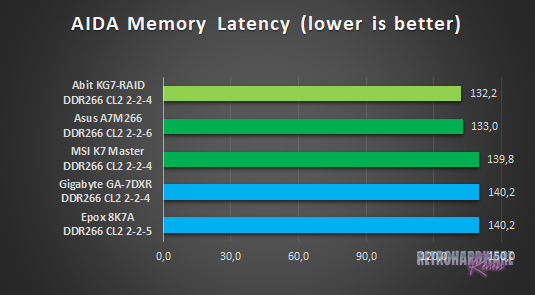
In terms of memory bandwidth, all AMD761 based boards perform very similar. The 8K7A takes second place here, but with the exception of the Abit KG7-RAID, all the boards show essentially the same level of performance. In the memory latency measurements, the EpoX board takes last place along with the Gigabyte GA-7DXR, with the MSI board closely ahead. The apperently more optimized boards from Asus and Abit show considerably better values.
Application Performance: 7-Zip

In the 7-Zip benchmark, we see a similar picture - the 8K7A ranks last along with Gigabyte's board, closely following the MSI K7 Master.
AGP Performance: Final Reality Benchmark


The EpoX 8K7A ranks third in the AGP bandwidth test for the Geforce 4 Ti with just over 290 MB/s. With the Voodoo 5 installed, all boards perform virtually identical.
AGP and PCI Performance: 3DMark 2000 and ATTO
3DMark 2000 as a whole is very focused on TnL and is by far not as interesting for retro-hardware comparisons as its predecessor. Its “High Polygon Count, 1 Light” test, however, is another good way to measure the AGP performance. In opposite to the Final Reality test, the general system performance is also somewhat of importance. The benchmark was executed with the Geforce 4 Ti installed.
To measure PCI performance, I installed a Windows 98SE compatible SATA controller with a Samsung PM871 128GB SSD connected into the system. For the bench, I chose 1024 to 4096 KB block size and picked the overall best values for the read and write throughput. This test will show, which maximum performance can be expected with fast storage options like SATA or SCSI and maybe gives a hint, if the chipset might be good for Voodoo 2 cards.
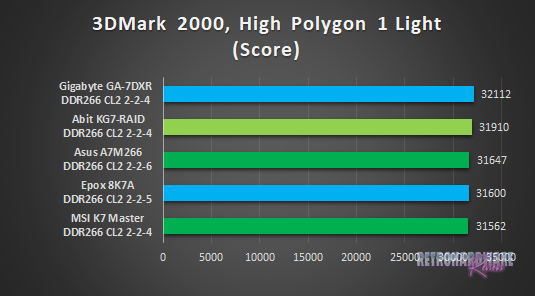

The 8K7A ranks fourth in 3DMark2000's "High Polygon, 1 Light" sub-test, between the Asus A7M266 and the MSI K7 Master, which show a comparable performance. In the PCI bandwidth test, we see very good results by all participants. The Epox board shows the second highest read rate here and the lowest write rate, of which the latter is still over 100 MB/s and only 2,5 MB/s behind the fastest board.
Storage Performance: HDTach
To measure the performance of the board's IDE and (if available) onboard IDE RAID solutions' performance, I benched one of the latest and fastest IDE drives (the Hitachi Deskstar T7K500 500GB) with the HDTach benchmark. I also tried a much more “recent” drive (the Western Digital Blue Edition 500GB), which should be even faster in theory, but the Hitachi drive produced much better results in this test.

Judging from the results, it seems like the 8K7A is limited to UDMA66, although the VIA southbridge provides an UDMA100 interface for IDE. But EpoX is not alone with this, the boards of Gigabyte and Abit show the same behaviour.
Gaming Benchmarks
Now that we got all the theoretical performance numbers, let's see how the contenders perform in 3D gaming benchmarks.
3D Performance: 3DMark99max
3DMark99max was released in early 1999 and comes without support for Hardware TnL. The maximum supported (hardware-) DirectX level is DX6. It is a great benchmark to reveal good overall system performance, as it rewards good memory bandwidth and latency more than the slight clockspeed advantage, that some boards have because of their factory-overclocked FSBs.
- Version: "latest"
- Settings: standard
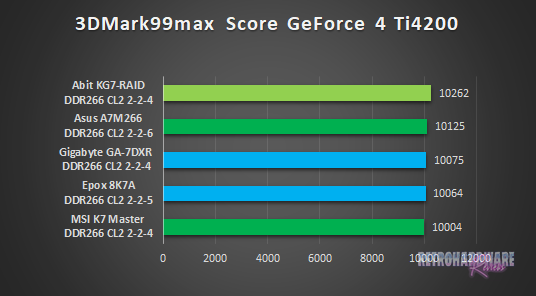

Two additional fourth places for the 8K7A, although it scores just about ten points short of the third-placed boards in both cases.


The 8K7A takes second place for the Voodoo 2 SLI run of 3DMark99max. The results are very close however, with first and fourth place only about thirty points apart. In terms of CPU performance in 3DMark99max, the Abit and Asus boards are slightly ahead of the other boards, but the 8K7A is the "Best of the Rest" at third place.
3D Performance: Unreal Tournament (UT99) Timedemo(s)
Unreal Tournament (UT99) was released in November 1999 and is notorious for its hunger for CPU power. I chose to use two different timedemos for comparison, of which the utbench.dem timedemo is heavily CPU bound and therefore qualifies to measure the general performance of the boards. The second timedemo benchmark.dem is as GPU limited as possible in this game. This will reveal, how much impact a faster board can still have in more GPU limited situations. This game is also perfect to show, on which chipsets and boards Voodoo 2 cards run best.
- Version: 4.36
- Settings: High, Min desired Framerate "0", Show Decals [x], Use Dynamic Lightning [x]
- Geforce: D3D
- Voodoo 2 and Voodoo 5: Glide


The result for the CPU bound utbench timedemo is quite good. Although the 8K7A takes the last place, it is only 0,65 FPS behind the first place in terms of average framerate and achieves the best minimum FPS.
It also shows the lowest average framerate in the benchmark.dem timedemo but this time, the differences are a bit more noticeable. Even compared to the fourth-placed MSI K7 Master, it achieves about 1 FPS less on average. The minimum FPS are still quite good, however.

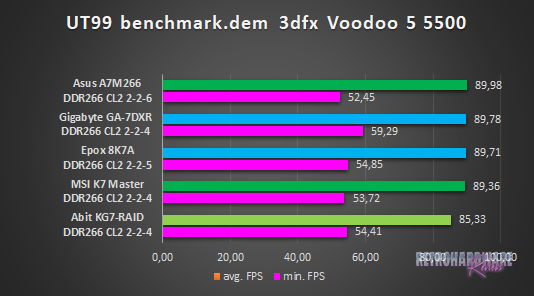
With the Voodoo 5 installed, the utbench results are even closer. The EpoX board ranks third here, along with the GA-7DXR, which has a slight advantage in minimum FPS. In the benchmark.dem timedemo, place one through four are extremely close in terms of average framerate, the differences can rather be found in the achieved minimum framerate. The EpoX 8K7A does well here, with the second best min. FPS and the third best average framerate.

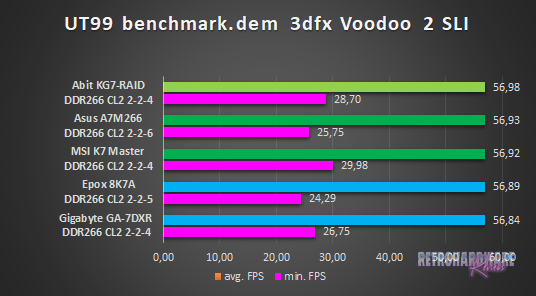
The average framerates in the utbench timedemo are only about 0,5 FPS apart, so the main difference lies once again the minimum FPS. The 8K7A shows a very good result here, achieving almost 1 FPS more in minimum framerate than most other boards. Only the Abit KG7-RAID comes close.
Interstingly enough, the Epox board shows the lowest min. FPS in the benchmark.dem timedemo, which are only slightly higher than in the CPU limited utbench timedemo. All other boards show better performances here. In terms of average FPS, all boards show virtually identical performance.
3D Performance: Quake III Arena Timedemo
Quake 3 Arena was released shortly after Unreal Tournament, in December of 1999. It is known to reward fast memory latency and with its normal preset, it is completely CPU limited; at least for the GeForce 4 and the Voodoo 5. The Voodoo 2 SLI cards clearly limit the Athlon 1200 here, as the timedemo will show.
- Version: 1.32
- Settings: “Normal” Preset, only resolution changed to 1024x768x16
- Geforce 5 and Voodoo5: OpenGL
- Voodoo 2: “Voodoo” Renderer (miniGL)


The 8K7A performs around the level of the Gigabyte GA-7DXR and MSI's K7 Master with both the Geforce 4 Ti and the Voodoo 5.
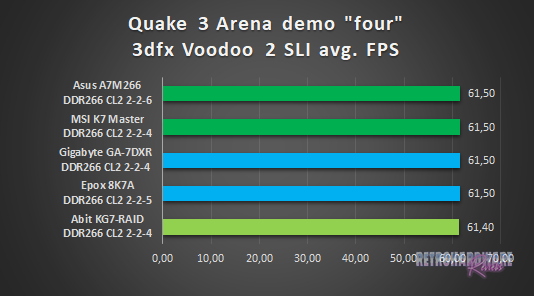
The Voodoo 2 SLI setup clearly limits here. All boards score the same FPS, with only the Abit KG7-RAID a close 0,1 FPS behind.
Summary & Rating
EpoX EP-8K7A (AMD760)
-
Layout
-
Features
-
Overclocking Options
-
Compatibility
-
Documentation & Support
-
Performance: GeForce 4 Ti 4200
-
Performance: Voodoo 5 5500
-
Performance: Voodoo 2 SLI
OVERALL
| Pros | Cons |
| + Fantastic PCI performance | – Most OC is done via DIP Switches and Jumpers |
| + Good layout | – Only two memory slots |
| + Diag Display | – CPU cooler compatibility (through-hole mounting) |





